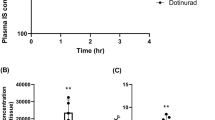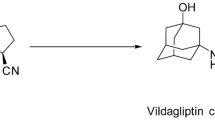Abstract
Background
Recent clinical studies have shown that increased serum levels of p-cresyl sulfate (PCS), a uremic toxin, are associated with the progression of chronic kidney disease (CKD) and cardiovascular outcomes. Using rat renal cortical slices, we previously reported that the rat organic anion transporter (OAT) could play a key role in the renal tubular secretion of PCS. However, no information is currently available regarding the transport of PCS via human OAT (hOAT) isoforms, hOAT1 and hOAT3.
Methods
Uptake experiments of PCS were performed using HEK293 cells, which stably express hOAT1 or hOAT3.
Results
PCS was taken up by hOAT1/HEK293 and hOAT3/HEK293 cells in a time- and concentration-dependent manner. The apparent K m for the hOAT1-mediated transport of PCS was 128 μM, whereas in hOAT3/HEK293, saturation was not observed at the highest tested PCS concentration of 5 mM. Probenecid, an OAT inhibitor, inhibited PCS transport by hOAT1 and hOAT3. The uptake of p-aminohippurate by hOAT1 and estron-3-sulfate by hOAT3 was decreased with increasing PCS concentration. The apparent 50 % inhibitory concentrations for PCS were 690 and 485 μM for hOAT1 and hOAT3, respectively.
Conclusion
PCS is a substrate for hOAT1 and hOAT3, and hOAT1 and hOAT3 appear to play a physiological role as a high-capacity PCS transporter. Since hOATs are expressed not only in the kidneys, but also in blood vessels and osteoblasts, etc., these findings are of great significance in terms of elucidating the renal clearance, tissue disposition of PCS and the mechanism of its toxicity in CKD.




Similar content being viewed by others
References
Lekawanvijit S, Kompa AR, Wang BH, et al. Cardiorenal syndrome: the emerging role of protein-bound uremic toxins. Circ Res. 2012;111(11):1470–83.
Martinez AW, Recht NS, Hostetter TH, et al. Removal of P-cresol sulfate by hemodialysis. J Am Soc Nephrol. 2005;16(11):3430–6.
de Loor H, Bammens B, Evenepoel P, et al. Gas chromatographic-mass spectrometric analysis for measurement of p-cresol and its conjugated metabolites in uremic and normal serum. Clin Chem. 2005;51(8):1535–8.
Liabeuf S, Barreto DV, Barreto FC, et al. Free p-cresylsulphate is a predictor of mortality in patients at different stages of chronic kidney disease. Nephrol Dial Transplant. 2010;25(4):1183–91.
Wu IW, Hsu KH, Hsu HJ, et al. Serum free p-cresyl sulfate levels predict cardiovascular and all-cause mortality in elderly hemodialysis patients–a prospective cohort study. Nephrol Dial Transplant. 2012;27(3):1169–75.
Lin CJ, Pan CF, Liu HL, et al. The role of protein-bound uremic toxins on peripheral artery disease and vascular access failure in patients on hemodialysis. Atherosclerosis. 2012;225(1):173–9.
Sun CY, Chang SC, Wu MS. Uremic toxins induce kidney fibrosis by activating intrarenal renin-angiotensin-aldosterone system associated epithelial-to-mesenchymal transition. PLoS ONE. 2012;7(3):e34026.
Watanabe H, Miyamoto Y, Honda D, et al. p-Cresyl sulfate causes renal tubular cell damage by inducing oxidative stress by activation of NADPH oxidase. Kidney Int. 2013;83(4):582–92.
Sun CY, Chang SC, Wu MS. Suppression of Klotho expression by protein-bound uremic toxins is associated with increased DNA methyltransferase expression and DNA hypermethylation. Kidney Int. 2012;81(7):640–50.
Deguchi T, Ohtsuki S, Otagiri M, et al. Major role of organic anion transporter 3 in the transport of indoxyl sulfate in the kidney. Kidney Int. 2002;61(5):1760–8.
Deguchi T, Kusuhara H, Takadate A, et al. Characterization of uremic toxin transport by organic anion transporters in the kidney. Kidney Int. 2004;65(1):162–74.
Enomoto A, Niwa T. Roles of organic anion transporters in the progression of chronic renal failure. Ther Apher Dial. 2007;11(Suppl 1):S27–31.
Adijiang A, Goto S, Uramoto S, et al. Indoxyl sulphate promotes aortic calcification with expression of osteoblast-specific proteins in hypertensive rats. Nephrol Dial Transplant. 2008;23(6):1892–901.
Yamamoto H, Tsuruoka S, Ioka T, et al. Indoxyl sulfate stimulates proliferation of rat vascular smooth muscle cells. Kidney Int. 2006;69(10):1780–5.
Iwasaki Y, Yamato H, Nii-Kono T, et al. Administration of oral charcoal adsorbent (AST-120) suppresses low-turnover bone progression in uraemic rats. Nephrol Dial Transplant. 2006;21(10):2768–74.
Nii-Kono T, Iwasaki Y, Uchida M, et al. Indoxyl sulfate induces skeletal resistance to parathyroid hormone in cultured osteoblastic cells. Kidney Int. 2007;71(8):738–43.
Poesen R, Viaene L, Verbeke K, et al. Renal clearance and intestinal generation of p-cresyl sulfate and indoxyl sulfate in CKD. Clin J Am Soc Nephrol. 2013.
Miyamoto Y, Watanabe H, Noguchi T, et al. Organic anion transporters play an important role in the uptake of p-cresyl sulfate, a uremic toxin, in the kidney. Nephrol Dial Transplant. 2011;26(8):2498–502.
Watanabe H, Miyamoto Y, Otagiri M, et al. Update on the pharmacokinetics and redox properties of protein-bound uremic toxins. J Pharm Sci. 2011;100(9):3682–95.
Mutsaers HA, Wilmer MJ, van den Heuvel LP, et al. Basolateral transport of the uraemic toxin p-cresyl sulfate: role for organic anion transporters? Nephrol Dial Transplant. 2011;26(12):4149.
Feigenbaum J, Neuberg CA. Simplified method for the preparation of aromatic sulfuric acid esters. J Am Chem Soc. 1941;63(12):3529–30.
Hosoyamada M, Sekine T, Kanai Y, et al. Molecular cloning and functional expression of a multispecific organic anion transporter from human kidney. Am J Physiol. 1999;276(1 Pt 2):F122–8.
Cha SH, Sekine T, Fukushima JI, et al. Identification and characterization of human organic anion transporter 3 expressing predominantly in the kidney. Mol Pharmacol. 2001;59(5):1277–86.
Duranton F, Cohen G, De Smet R, et al. Normal and pathologic concentrations of uremic toxins. J Am Soc Nephrol. 2012;23(7):1258–70.
Sakai T, Takadate A, Otagiri M. Characterization of binding site of uremic toxins on human serum albumin. Biol Pharm Bull. 1995;18(12):1755–61.
Watanabe H, Noguchi T, Miyamoto Y, et al. Interaction between two sulfate-conjugated uremic toxins, p-cresyl sulfate and indoxyl sulfate, during binding with human serum albumin. Drug Metab Dispos. 2012;40(7):1423–8.
Matsuo H, Takada T, Ichida K, et al. Common defects of ABCG2, a high-capacity urate exporter, cause gout: a function-based genetic analysis in a Japanese population. Sci Transl Med 2009;1(5):5ra11.
Mikkaichi T, Suzuki T, Onogawa T, et al. Isolation and characterization of a digoxin transporter and its rat homologue expressed in the kidney. Proc Natl Acad Sci USA. 2004;101(10):3569–74.
Yamaguchi H, Sugie M, Okada M, et al. Transport of estrone 3-sulfate mediated by organic anion transporter OATP4C1: estrone 3-sulfate binds to the different recognition site for digoxin in OATP4C1. Drug Metab Pharmacokinet. 2010;25(3):314–7.
Ekaratanawong S, Anzai N, Jutabha P, et al. Human organic anion transporter 4 is a renal apical organic anion/dicarboxylate exchanger in the proximal tubules. J Pharmacol Sci. 2004;94(3):297–304.
Jutabha P, Anzai N, Kitamura K, et al. Human sodium phosphate transporter 4 (hNPT4/SLC17A3) as a common renal secretory pathway for drugs and urate. J Biol Chem. 2010;285(45):35123–32.
Giacomini KM, Balimane PV, Cho SK, et al. International transporter consortium commentary on clinically important transporter polymorphisms. Clin Pharmacol Ther. 2013;94(1):23–6.
Acknowledgments
This work was supported by a Grant-in-Aid for Scientific Research from Japan Society for the Promotion of Science (JSPS) [KAKENHI 23790187].
Conflict of interest
The authors declare no conflict of interest.
Author information
Authors and Affiliations
Corresponding author
About this article
Cite this article
Watanabe, H., Sakaguchi, Y., Sugimoto, R. et al. Human organic anion transporters function as a high-capacity transporter for p-cresyl sulfate, a uremic toxin. Clin Exp Nephrol 18, 814–820 (2014). https://doi.org/10.1007/s10157-013-0902-9
Received:
Accepted:
Published:
Issue Date:
DOI: https://doi.org/10.1007/s10157-013-0902-9




